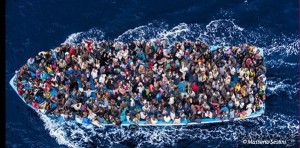Sea Migration Lecture at NYU
 April 13 (6 pm). Mare Nostrum, Mundus Noster – Our Sea, Our World: Refugees Crossing the Mediterranean and the Humanitarian Response. Villa Sassetti within NYU Florence: Via Bolognese 120.
April 13 (6 pm). Mare Nostrum, Mundus Noster – Our Sea, Our World: Refugees Crossing the Mediterranean and the Humanitarian Response. Villa Sassetti within NYU Florence: Via Bolognese 120.
R.S.V.P. required at lapietra.dialogues@nyu.edu or 055 5007 202.
We have all heard the terrors of events such as the 2013 Lampedusa migrant shipwreck, but the news doesn’t involve much of these immigrants’ lives past this. How do humanitarian efforts respond to people who complete their journey to Italy?
This is the theme of a free conference in English open to the public at Villa La Pietra on the New York University campus. The event will feature guest speakers Flavio di Giacomo, Public Information Officer and Spokesperson of the International Organization for Migration, Coordination office in Rome; Cristopher Hein, Director of the Italian Council for Refugees; and Carlotta Sami, spokesperson for the United Nations High Commissioner for Refugees.
Amid crises, war, and precarious economies, people applying for asylum in a European Union member state has increased 25 percent from 2013 to 2014. In total, as of July 2014, 98,813 immigrants are residing in Italy. This includes 76,263 refugees, 22,200 asylum seekers, and 350 stateless persons.
Refugees are defined as: persons who are forced to leave their country in order to escape war, persecution or natural disasters; asylum seekers are: persons who have left their home country as a political refugee and are seeking asylum in another; and stateless persons are those who are not considered nationals by any state.
One main focus will Mare Nostrum, an operation launched in October of 2013. This operation rescued over 140,000 people crossing borders through irregular channels. As defined by the EU commission, irregular channels are those that do not comply with the necessary requirements for legal entry into a country.
In 2014, however, Italy announced that Mare Nostrum was overtaken by the Frontex operation Triton. According to the European Council on Refugees and Exiles, Triton only has a small budget of three million euros per month, whereas Mare Nostrum’s budget was nine million per month. Additionally, although Triton is a Frontex effort, only 8 of the 27 EU Member States have provided equipment, while specialized personnel has been provided by 12 countries.
From Mare Nostrum, where the main objective was the safety and rescue of immigrants, Triton’s primary focus is “border management,” according to Frontex.
Triton was initiated at the United Nations level; however, spurred by the February 2015 Mediterranean boat tragedies where about 300 people died or went missing, the UN High Commissioner for Refugees Antonio Guterres characterized the Triton operation as “a woefully inadequate replacement for Italy’s Mare Nostrum.”
The event is part of Villa La Pietra’s dialogue on “Black Italia” that aims to show how Africans are characterized throughout Italian history and culture, as well as current effects of immigration on Italy today. This dialogue leads us to NYU Florence’s spring exhibition, “ReSignifications” and the international conference “Black Portraitures{S}II: Imaging The Black Body and Re-Staging Histories.”
Claudia Cereceda organized “Mare Nostrum, Mundus Noster.” She is a Global Liberal Studies major at NYU with a concentration in Politics, Rights, and Development who is particularly interested in exploring the human beings behind statistics. Cereceda will be completing her senior thesis May 2016 about the evolution of immigration in Italy. As a member of the Global Liberal Studies program, Cereceda has been able to spend most of her NYU career at the Florence campus and has been working with La Pietra Dialogues since Fall 2012. (angela karl)
